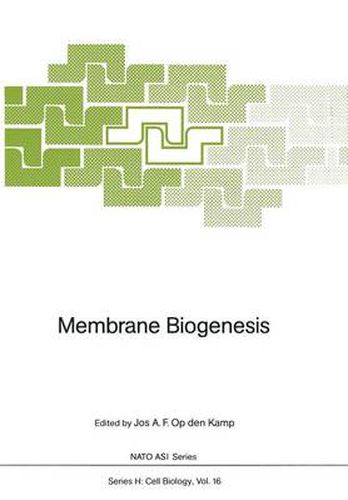Readings Newsletter
Become a Readings Member to make your shopping experience even easier.
Sign in or sign up for free!
You’re not far away from qualifying for FREE standard shipping within Australia
You’ve qualified for FREE standard shipping within Australia
The cart is loading…






This title is printed to order. This book may have been self-published. If so, we cannot guarantee the quality of the content. In the main most books will have gone through the editing process however some may not. We therefore suggest that you be aware of this before ordering this book. If in doubt check either the author or publisher’s details as we are unable to accept any returns unless they are faulty. Please contact us if you have any questions.
Many individual aspects of the dynamics and assembly of biological membranes have been studied in great detail. Cell biological approaches, advanced genetics, biophysics and biochemistry have greatly contributed to an increase in our knowledge in this field.lt is obvious however, that the three major membrane constituents - lipids, proteins and carbohydrates- are studied, in most cases separately and that a coherent overview of the various aspects of membrane biogenesis is not readily available. The NATO Advanced Study Institute on New Perspectives in the Dynamics of Assembly of Biomembranes intended to provide such an overview: it was set up to teach students and specialists the achievements obtained in the various research areas and to try and integrate the numerous aspects of membrane assembly into a coherent framework. The articles in here reflect this. Statting with detailed contributions on phospholipid structure, dynamics, organization and biogenesis, an up to date overview of the basic, lipidic backbone of biomembranes is given. Extensive progress is made in the research on membrane protein biosynthesis. In particular the post- and co-translational modification processes of proteins, the mechanisms of protein translocation and the sorting mechanisms which are necessary to direct proteins to their final, intra - or extracellular destination have been characterized in detail. Modern genetic approaches were indispensable in this research area: gene cloning, hybrid protein construction, site directed mutagenesis and sequencing techniques elucidated many functional aspects of specific nucleic acid and amino acid sequences.
$9.00 standard shipping within Australia
FREE standard shipping within Australia for orders over $100.00
Express & International shipping calculated at checkout
This title is printed to order. This book may have been self-published. If so, we cannot guarantee the quality of the content. In the main most books will have gone through the editing process however some may not. We therefore suggest that you be aware of this before ordering this book. If in doubt check either the author or publisher’s details as we are unable to accept any returns unless they are faulty. Please contact us if you have any questions.
Many individual aspects of the dynamics and assembly of biological membranes have been studied in great detail. Cell biological approaches, advanced genetics, biophysics and biochemistry have greatly contributed to an increase in our knowledge in this field.lt is obvious however, that the three major membrane constituents - lipids, proteins and carbohydrates- are studied, in most cases separately and that a coherent overview of the various aspects of membrane biogenesis is not readily available. The NATO Advanced Study Institute on New Perspectives in the Dynamics of Assembly of Biomembranes intended to provide such an overview: it was set up to teach students and specialists the achievements obtained in the various research areas and to try and integrate the numerous aspects of membrane assembly into a coherent framework. The articles in here reflect this. Statting with detailed contributions on phospholipid structure, dynamics, organization and biogenesis, an up to date overview of the basic, lipidic backbone of biomembranes is given. Extensive progress is made in the research on membrane protein biosynthesis. In particular the post- and co-translational modification processes of proteins, the mechanisms of protein translocation and the sorting mechanisms which are necessary to direct proteins to their final, intra - or extracellular destination have been characterized in detail. Modern genetic approaches were indispensable in this research area: gene cloning, hybrid protein construction, site directed mutagenesis and sequencing techniques elucidated many functional aspects of specific nucleic acid and amino acid sequences.